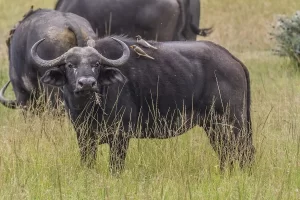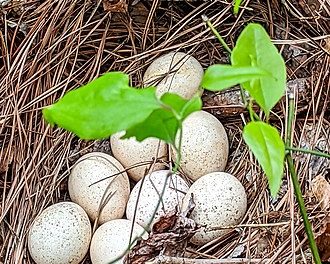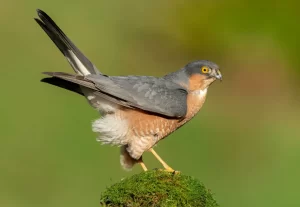African buffalo are large, heavy cow-like animals native to Africa. They are widely regarded as among the most dangerous animals on the African continent, and according to some estimates they gore, trample, and kill over 200 people every year. Compared with other large bovids, African buffalo have a long but stocky body and short but thickset legs, resulting in a relatively short standing height.

African buffalo
The adult buffalo’s horns are its characteristic feature: they have fused bases, forming a continuous bone shield across the top of the head referred to as a “boss”. Savannah-type buffalo have black or dark brown coats with age. Old bulls often have whitish circles around their eyes and on their face. Females tend to have more-reddish coats. Forest-type buffaloes are 30-40% smaller, reddish-brown in color, with much more hair growth around the ears and with horns that curve back and slightly up. Calves of both types have red coats.
This Pritish Kumar article helps you to get detailed knowledge about African buffalo.
Distribution
African buffalo occur in Sub-Saharan Africa. They live in swamps and floodplains, as well as mopane grasslands, and the forests of the major mountains of Africa. They prefer a habitat with dense cover, such as reeds and thickets.

Range of African buffalo
But can also be found in open woodland, montane grasslands and forest, savannas, and moist lowland rainforests. These large animals require water daily, and so they depend on perennial sources of water. Buffalo do not stay on trampled or depleted areas for long.
Habits and Lifestyle
African buffalo may be active throughout the day and night. They are social and live in herds which consist of related females, and their offspring, in an almost linear dominance hierarchy. The basic herds are surrounded by subherds of subordinate males, high-ranking males and females, and old or invalid animals.

African buffalo – habits
The young males keep their distance from the dominant bull, which is recognizable by the thickness of his horns. During the dry season, males leave the herd and form, bachelor groups. Two types of bachelor herds occur: ones made of males aged 4 to 7 years and those of males 12 years or older. During the wet season, the younger bulls rejoin a herd to mate with the females. They stay with them throughout the season to protect the calves. Males have a linear dominance hierarchy based on age and size.
Since a buffalo is safer when a herd is larger, dominant bulls may rely on subordinate bulls and sometimes tolerate their copulation. When chased by predators, a herd sticks close together and makes it hard for the predators to pick off one member. Calves are gathered in the middle. A buffalo herd responds to the distress call of a captured member and tries to rescue it. African buffalo make various vocalizations. They emit low-pitched calls to signal the herd to move. To signal to the herd to change direction, leaders emit “gritty”, “creaking gate” sounds. When moving to drinking places, some individuals make long “maaa” calls up to 20 times a minute.

African buffalo – drinking places
When being aggressive, they make explosive grunts that may last long or turn into a rumbling growl. Cows produce croaking calls when looking for their calves. Calves make a similar call of a higher pitch when in distress. When threatened by predators, they make drawn-out “waaaa” calls. When grazing, they make various sounds, such as brief bellows, grunts, honks, and croaks.
Diet and Nutrition
African buffalo have a strictly herbivorous (graminivorous, folivorous) diet.

African buffalo eating
They feed on a wide variety of grasses, sedges, leaves, and other plants.
Mating Habits
African buffalo are polygynandrous (promiscuous) meaning that both males and females mate with multiple partners. They mate and give birth only during the rainy seasons. Birth peak takes place early in the season, while mating peaks later. A dominant bull in the herd/subherd closely guards a cow that is ready to mate and keeps other bulls at bay.
This is difficult, as cows are quite evasive and attract many males to the scene. Cows usually reproduce every two years. They give birth to a single calf after a gestation period of 11.5 months. Newborn calves remain hidden in vegetation for the first few weeks while being nursed occasionally by the mother before joining the main herd. Older calves are held in the center of the herd for safety. Calves are typically weaned by 9 or 10 months. The maternal bond between mother and her offspring lasts longer than in most bovids. However, when a new calf is born, the bonding ends and the mother keeps her previous offspring at bay with horn jabs.
Nevertheless, the yearling follows its mother for another year or so. Males leave their mothers when they are two years old and join the bachelor groups. African buffalo calves usually become independent between one and two years of age. Young females start breeding at 5 years of age. Males become reproductively mature when they are 4 to 6 years old.
Population
Population threats
The biggest threat to African buffalo is habitat loss due to fragmentation, expansion of settlements and agriculture, and livestock grazing. In the past, numbers of African buffalo suffered their most severe collapse during the great rinderpest epidemic of the 1890s, which, caused mortalities as high as 95% among livestock and wild ungulates.
Being a member of the big-five game family, a term originally used to describe the five most dangerous animals to hunt, the African buffalo is a sought-after trophy, with some hunters paying over $10,000 for the opportunity to hunt one. The larger bulls are targeted for their trophy value, although in some areas, buffalo are still hunted for meat.

African buffalo – gazing
Population number
According to the IUCN Red List, the total population size of African buffalo is approximately 569,000-573,000 individuals. This species’ numbers are decreasing and it is currently classified as Near Threatened (NT) on the IUCN Red List.
Ecological niche
African buffalo are very important grazers in their ecosystem. When grazing, herds of buffalo mow down grasses and make way for more selective grazers such as zebras and wildebeest.
Fun Facts for Kids
- The African buffalo is one of the most successful grazers in Africa. When feeding, the buffalo makes use of its tongue and wide incisor row to eat grass more quickly than most other African herbivores.
- African buffalo are very dependent on water and can consume 35 liters of water at a time just in few minutes.
- These massive animals are also excellent swimmers and often cross rivers in search of better grazing.
- Adult African buffalo bulls often spar in play, dominance interactions, or actual fights. A bull approaches another, lowing, with his horns down, and waits for the other bull to do the same thing. When sparring, the bulls twist their horns from side to side. If the sparring is for play, the bull may rub his opponent’s face and body during the sparring session. Actual fights are violent but rare and brief. Calves may also spar in play, but adult females rarely spar at all.
- African buffalo are notable for their apparent altruism. Females exhibit some sort of “voting behavior”. During resting time, the females stand up, shuffle around, and sit back down again. They sit in the direction they think they should move. After an hour of more shuffling, the females travel in the direction they decide. This decision is usually communal and not based on hierarchy or dominance.
- African buffalo are known to engage in mobbing behavior when fighting off predators. They have been recorded killing a lion and chasing lions up trees and keeping them there for two hours after the lions have killed a member of their group.
- Being one of the “big five” African game, the African buffalo is known as “the Black Death” or “widowmaker”, and is widely regarded as a very dangerous animal. Buffalo are sometimes reported to kill more people in Africa than any other animal.
Reference










